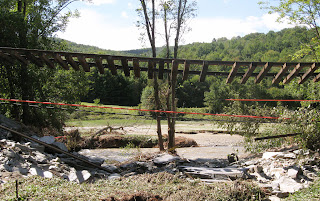The stream next to our house
Overruning the opposite bank
As the rainfall rate started to crank up, my husband and I went outside to get a better view of the teensy stream that runs at the back of our acreage, which was cresting its banks with leaping waves and had begun to flood the lower parts of the property. Happily, it had avoided our newly-planted apple grove and blueberry bushes. A wide, shallow river of muddy water was rushing toward a confluence with the larger stream whose course runs a few feet from our driveway, flowing from the hills across the road, under a small bridge and down to the Third Branch of the White River. When I bought this house in 1994, I made sure it wasn't in a flood plain but I also guessed that once the water flowed under the little bridge it had a wider place to go and therefore wouldn't rise to the top of our bank, 12 feet or so above the streambed. My gamble was correct and although Douglas snapped photos of the water's crest coming to within a foot or so of the roadbed of the bridge, severe damage was avoided except for a total rearrangement of the stream's course as well as some physical features of the landscape downstream. I also knew that our home, which is post-and-beam construction and built in 1830, had withstood the historic Vermont Flood of 1927. It had, in fact, sheltered men from the community who stayed here overnight so they could keep one bridge open off Braintree Hill by fending off large trees that were washing down the streambeds and threatening to demolish the bridge.
Floodwaters flowing under our bridge
We had experienced major flooding from a summer storm in 1998 and lots of roads in our nearest town, Randolph, were severely damaged that year. Earlier this spring, major work was done to replace aging culverts and this work was well-justified, as those previously-damaged areas came through with flying colors. The Amtrak trestles didn't do so well. In two sites the track was seen suspended in mid-air with nothing underneath for 20 feet.
Amtrak "suspension" bridge a mile from our home
Monday after the storm we ventured into town to get a cell-phone signal so we could call relatives and let them know we were ok. We began to see saturated furniture and household goods piled in front of homes and farms. Boulders and large trees were left in the middle of flattened hayfields, like strange sculptural installations. Stands of ripe corn were covered with gray mud. Parking lots had collapsed into streambeds, giant bites taken out of the asphalt. Stores had their doors open but without lights. We checked our local Aubuchon's Hardware and they told us generators were on the way. Shaw's Supermarket was running on generators but the shelves were still reasonably stocked. Randolph Village, which had been so hard hit in the Flood of '27, had survived the worst. At least our floodwaters had receded.
View from the bottom of our field-- normal streambed is to far right of photo
Battles Brook heading toward its meeting with Flint Brook
Battles Brook heading toward its meeting with Flint Brook
But many of our tiny villages and communities are still isolated and without power or a way to get out except by foot almost two weeks later. My husband's company had watermarks 5 feet up and mud all over their offices and manufacturing facilities. They will rebuild but it will take months and lots of physical labor and help from a backhoe. It's hard to believe that in 2011 our civilized world could be dealt such a blow from the forces of wind and water. You read about the tornados and the earthquakes and the tsunami but until the water's at your door, it doesn't seem real. We are lucky in Vermont that we still have some time to fix roads and find shelter for those whose homes were demolished before winter and the inevitable cold arrives. But the courage and fortitude (a word hardly used anymore) of my neighbors in dealing with this crisis makes me proud to be part of this community-- we're not whining, we're not looting, we are being generous with our resources and our homes, we are rebuilding by using our own hard work and hands, we are helping each other. In earlier times we did the same. It seems adversity serves to renew our trust in each other and our interdependence as a community.









I am your neighbor from Killington and I feel relief every time I hear of another Vermonter who survived the storm without serious damage. So many others have suffered incomprehensible losses. I still have trouble wrapping my head around the destruction I have seen and heard about. I, too, am proud of my fellow Vermonters, who are doing what is needed to help their neighbors, without being asked, and without asking for anything in return.
ReplyDeleteI've been wondering how you fared - good to hear you are safe. The forces of Nature are exactly that - forces - and they will always stronger than our civilized world...
ReplyDeleteSending prayers for your community. Stay safe, Christine.
Your stream became a raging river! I'm glad you were spared. This season has had helluva crazy weather. I think Mother Nature might be having a nervous breakdown! BTW, love the article in BAJ! You're the bomb!
ReplyDeleteI'm so scared of this stuff for you.
ReplyDelete